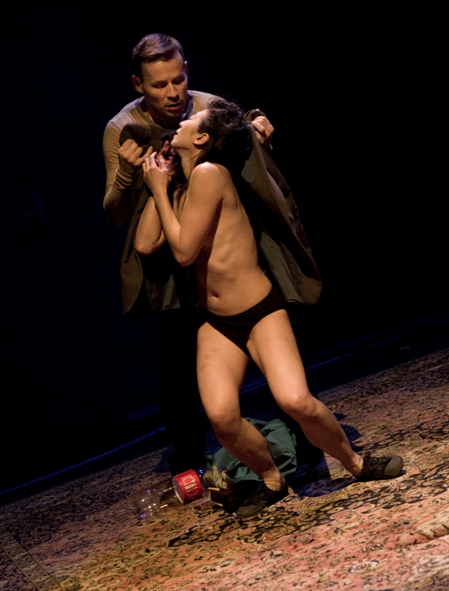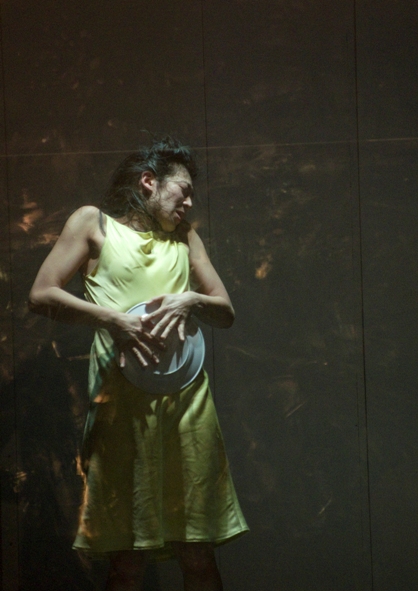Motif of Lobbying Accompanied by Voice and Movement
 Farm in the Cave presented a new piece Whistleblowers in the Ponec theatre. As is typical of this company, their "engagé" productions reveal social issues and comment on the problems of contemporary society. This time, the artistic director Viliam Dočolomanský deals with lobbying, the way it works and the influence of multinational food corporations on society – in the case of Whistleblowers specifically on lives of people in the Philippines, where UNICEF has found out that nearly one fourth of local mothers under the influence of ads on powdered milk do not breastfeed their children. This fact has aroused the whole implementing team, which Farm in the Cave engaged in field research – they took part in the session of the European Parliament in Brussels, consulted their findings with political scientists and also considered a real case, which in 2013 ended up at a court. All of this has laid the foundations for the new production that reveals alarming facts and although it deals with a specific case, the overall message is obvious. Dočolomanský has focused on a case that occurred in a somewhat distant country to us, so we have to relate it to our own experience, which is not that difficult – after all, the subject of manipulation and freedom has many forms.
Farm in the Cave presented a new piece Whistleblowers in the Ponec theatre. As is typical of this company, their "engagé" productions reveal social issues and comment on the problems of contemporary society. This time, the artistic director Viliam Dočolomanský deals with lobbying, the way it works and the influence of multinational food corporations on society – in the case of Whistleblowers specifically on lives of people in the Philippines, where UNICEF has found out that nearly one fourth of local mothers under the influence of ads on powdered milk do not breastfeed their children. This fact has aroused the whole implementing team, which Farm in the Cave engaged in field research – they took part in the session of the European Parliament in Brussels, consulted their findings with political scientists and also considered a real case, which in 2013 ended up at a court. All of this has laid the foundations for the new production that reveals alarming facts and although it deals with a specific case, the overall message is obvious. Dočolomanský has focused on a case that occurred in a somewhat distant country to us, so we have to relate it to our own experience, which is not that difficult – after all, the subject of manipulation and freedom has many forms.Whistleblowers inquire into what corporation actually entails – trying to find the chief "manager" of the entire system, who, however, is difficult to reach... Trade unions in the Philippines tried to resist the rules enforced by an unnamed food corporation, which, however, deployed a spy among them, who reported of their activities to the company’s management. She also warned them about the publication of a book revealing adverse testimonies – and many union leaders involved in the case died in unclear circumstances. All this is shown in Dočolomanský’s new project, which boasts linear and uncompromising dramaturgical and directorial traits.
Plain comments
A girl with Asian features, dressed in a purple leotard comes on the stage. She staggers like a gymnast on an imaginary balance beam and tells her story how she began to drink powdered milk because she got shoes for it and did not have to be barefoot anymore. Behind her there is a box separated by a transparent wall, which is broken in one place – through this hole one of the office workers working in the box - office offers a "helping hand" to the girl. Anyway, a handshake is treacherous because there is no escape from a well-established machinery. The girl eventually becomes the spy, fruitlessly trying to abort her mission.
The performers step out from the office box onto the stage, inertially moving back and forth, slightly revealing the pink lining of their jackets. They keep on tersely commenting on and quoting pieces of sensitive information – English text is translated and projected on the rear screen, which allows us to closely follow the action on stage. One of the actors-dancers captures with his camera details of the bodies of other performers who move around the stage. The movement is not rushed, it is rather bound to verbal declamations, expressive gestic sequences refer to computer typing and other administrative tasks. Everybody moves like a machine – all are controlled by something invisible, yet the consequences are tangible.
Drily, factually, without emotions
Expressive dynamic transitions from walking to running evoke an atmosphere of rush, stress and some kind of helplessness. All those trying to figure things out eventually succumb to this mood too. In one of the final moments a girl hides under a carpet with Persian patterns, lying at the back of the stage all the time. Four other companions follow her, they pull out brown tufts looking like hair, we can hear and read the names of the murdered activists. Eventually one of the men sits limply on the edge of the carpet and you can only guess whether it is the end of the performance just as the audience on the opening night did, hesitating whether to applaud or not for some time.
 In Whistleblowers there are physical, combat-like sequences with male performers, followed by subtle hustle of their female counterparts, we watch movement sequences that accompany the pre-selected text. The movement flows from one part of a body to another, without any anatomical continuity. Subtle slides go back and forth like a film tape that just got jammed; imperceptible sighs are followed by a free fall, after which at one point one of the performers slightly waves her arm. Two actors-dancers in a somewhat longer sequence play with plates, holding them in their mouths, putting them to their bodies, dancing with them and sending them across the floor away. Plates are important "food" to them, essential to their lives.
In Whistleblowers there are physical, combat-like sequences with male performers, followed by subtle hustle of their female counterparts, we watch movement sequences that accompany the pre-selected text. The movement flows from one part of a body to another, without any anatomical continuity. Subtle slides go back and forth like a film tape that just got jammed; imperceptible sighs are followed by a free fall, after which at one point one of the performers slightly waves her arm. Two actors-dancers in a somewhat longer sequence play with plates, holding them in their mouths, putting them to their bodies, dancing with them and sending them across the floor away. Plates are important "food" to them, essential to their lives.The bodies of the performers become a material through which they attempt to define their own body language, they search for signs that do not reproduce the text, but create a visual dimension of their own and break down movement stereotypes. For the audiences the bodies of the performers may become objects of their imagination they can identify with.
Whistleblowers are staged with great vigour and enthusiasm. Five performers (Emil Leeger, Minh-Hieu Nguyen, Hana Varadzinová, Anna Gromanová, Jun Wan Kim) have mastered not only a pronounced speech, but also their bodies (close to the end they are joined by another male performer – according to the programme, his name is Olda Smysl). They inform us like media do – drily, factually, without emotions. In over sixty minutes, an alarming case unfolds in front of us to the musical accompaniment by Marcel Bárta (electronic music mixes are followed by live inputs played on wind instruments). There are few lyrical moments there too, however, the story is dominated by raw physicality, unvarnished and devoid of any ideals. And this is what is typical of Farm in the Cave – discovering a peculiar body language, in this case somewhat less aggressive than the subject itself suggests.
Written from the opening night on April 1st, 2014, Ponec theatre.
Whistleblowers
Stage direction, concept and choreography: Viliam Dočolomanský
Music: Viliam Dočolomanský and Marcel Bárta
Stage design: Lucia Škadíková
Costumes: Markéta Oslzlá
Lighting design: Felice Ross
Video: Erik Bartoš
Premiere: April 1st, 2014 Translation: Tomáš Valníček


